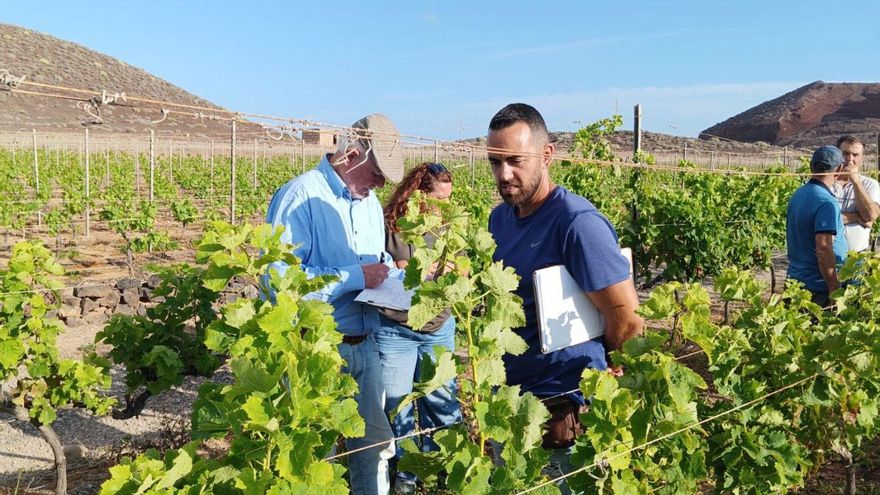
- The phylloxera plague has yet to reach the south of Tenerife, but it has affected the northern area.
- Should the epidemic spread across the Island, how would work in the fields and wineries change?
- The death of the plant starts at the root.
- What would an uncontrolled phylloxera outbreak mean for the wine sector of Abona?
- Could this also lead to the loss of traditional grape varieties?
- “The sector suffers from problems of generational change, and another issue could sink it further.”
- In the event of an outbreak, precautionary measures must be intensified.
- What is the main issue affecting the Island’s vineyards, and why are they so vulnerable to this plague?
- How are the vintners in the region coping?
- What tools are being used to prevent the plague from reaching southern Tenerife?
- “It must be understood that the roots of our vineyards are not resistant to the phylloxera plague.”
- Are checks being carried out on plots to ensure they are free from phylloxera?
- Could this situation affect the prestige and marketing of the Island’s and region’s wines?
- Could this crisis help foster unity within the wine sector?
The phylloxera plague has yet to reach the south of Tenerife, but it has affected the northern area.
The Denomination of Origin of Abona, which includes the municipalities of Adeje, Arona, Vilaflor, San Miguel de Abona, Granadilla, Arico, and Fasnia, is characterised by its wine-producing region that features a dry climate, porous volcanic soils, and a wide range of altitudes suitable for growing different grape varieties. These characteristics make it challenging for the plague to proliferate in the area.
Should the epidemic spread across the Island, how would work in the fields and wineries change?
If such a situation were to occur, it would further discourage many vintners who are already on the brink of abandoning their vineyards. This abandonment is due to a lack of profitability and a generational gap. For the wineries, a significant reduction in the influx of grapes would be one of the major impacts should the plague spread.
The death of the plant starts at the root.
Indeed, this leads to a kind of silent death. The leaves of the plant turn yellow. If you do not notice them, it becomes a problem. However, since vines are deciduous plants, the leaves naturally fall off, meaning you might not see the yellowing leaves.
What would an uncontrolled phylloxera outbreak mean for the wine sector of Abona?
It would bring widespread concern. This issue would not just affect this part of the Island but the entire sector as a whole. This virus is detrimental to vineyards and could severely impact the availability of grapes.
Could this also lead to the loss of traditional grape varieties?
Exactly. It could also impact wine tourism. Our sector already faces challenges with generational changes and drought. As if this were not enough, another problem could increase the abandonment of the vineyards.
“The sector suffers from problems of generational change, and another issue could sink it further.”
In the event of an outbreak, precautionary measures must be intensified.
This would entail restrictions on actions. Our vineyards are on their own roots and would not withstand a phylloxera attack. Although historical literature suggests that this plague does not thrive in sandy and volcanic soils, which are prevalent in our region, it is also true that there are areas highly susceptible to this virus, capable of severely affecting the entire system.
What is the main issue affecting the Island’s vineyards, and why are they so vulnerable to this plague?
The problem lies in the fact that the roots of our vineyards are not resistant to the plague. We are somewhat at risk in this aspect. In other parts of the world, what is done is to plant an American vine that can withstand phylloxera, and then graft a European variety on top, which is more suitable for wine production. As we lack this, we are more affected.
How are the vintners in the region coping?
They have a medium-high level of concern. On one hand, we can say they feel reassured because the Cabildo and the Government of the Canary Islands are doing a good job. However, there is also worry because no one is prepared for this situation. We live in a bubble where we sell our pre-phylloxera wines, but once the plague enters, we do not have measures to stop it.
What tools are being used to prevent the plague from reaching southern Tenerife?
In our case, the best tool is community engagement. The first step we have taken is to disseminate information on how to identify the plague so that people can recognise it.
“It must be understood that the roots of our vineyards are not resistant to the phylloxera plague.”
Are checks being carried out on plots to ensure they are free from phylloxera?
Yes. This is another tool we use to prevent the plague. This happens because some people in the region sell wine outside, and the vintner can request the Cabildo to check the status of their plot.
Could this situation affect the prestige and marketing of the Island’s and region’s wines?
The prestige of a wine comes from its quality, as well as its uniqueness. Our wines are known for their character and quality, so this would not be affected. However, it could lead to a sudden drop in wine production levels, negatively impacting both domestic and international marketing.
Could this crisis help foster unity within the wine sector?
An outbreak could bring the sector together, encouraging collaboration, joint advocacy for aid, and the defence of local varieties through research aimed at creating more resilient vineyards and improving management techniques.













